Day 3 of a three day long weekend of Winter Tours in North Norfolk today, our last day. After a frosty start, it was a glorious, sunny winter’s day. Great weather to be out birding.
On our way west, the excitement started already. A Peregrine swept over the road and stooped down at a flock of Woodpigeons in a field. Unfortunately it disappeared behind a hedge so we couldn’t see if it was successful. A few feathers floated past either lost in the panic or in a chase. We also passed several small flocks of Pink-footed Geese in fields where the sugar beet had recently been harvested, looking for food.
Our first destination was Snettisham. It was high tide when we arrived, but not a really big one. Although the tide was already in, there was still lots of mud left uncovered. We could see some huge flocks of Knot out on the mudflats as we arrived at the seawall, tight groups thousands strong glinting white in the morning sunshine. As we made our way along the seawall, they suddenly took flight and started whirling round. It was quite a display, flashing alternately bright white underneath and dark grey as they wheeled and banked.
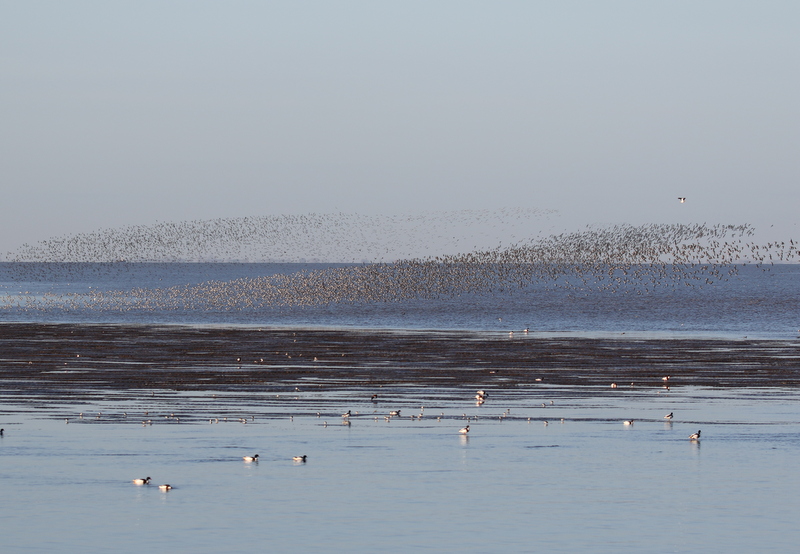
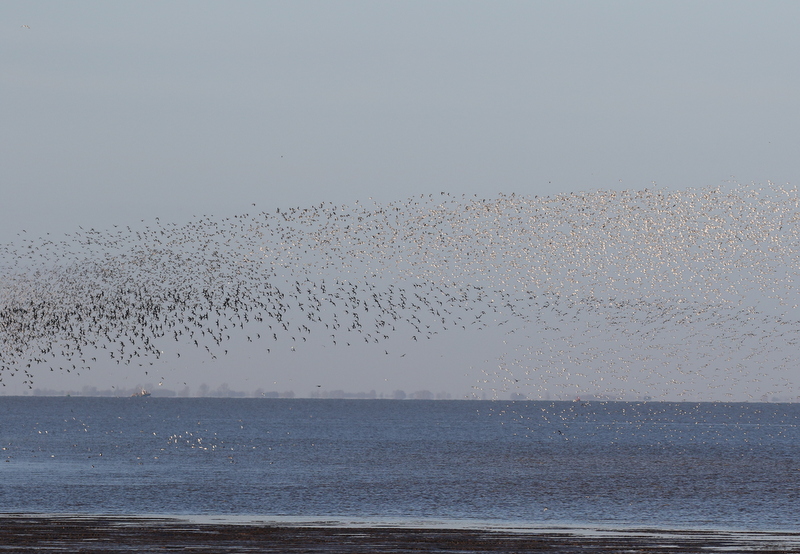

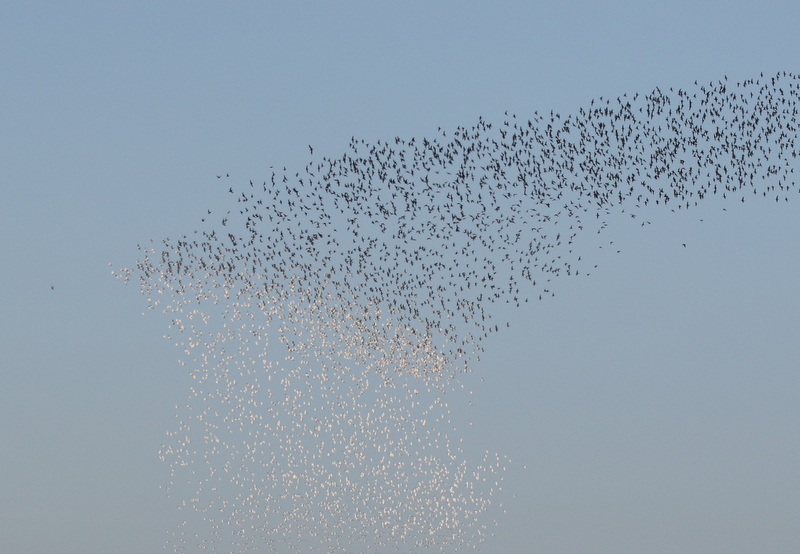 Knot – swirling over the Wash
Knot – swirling over the Wash
It didn’t take long to find out the reason for the Knots’ nervousness. A Peregrine appeared, circling over the mud at the front of the melee. It turned and powered back into the swirling flocks, flying fast and low over the mud, and the next thing we knew we could see two Peregrines circling together further back. After chasing after the waders for a few minutes, seemingly unsuccessfully, they seemed to lose interest and drifted away south.
The Knot gradually returned to the mud and as things settled down again we had a look for other waders out on the Wash. A large flock of Oystercatchers had been relatively unperturbed by the Peregrines, and they had remained standing out on the mud all along. There were also plenty of Dunlin, Grey Plover and Bar-tailed Godwits. The flocks of Golden Plover commuted back and forth between the fields inland and the mud.
There was a nice selection of ducks too. Lots of Shelduck and Teal, plus a good number of Wigeon, mostly out along the edge of the mud. Scanning through them, we found a little group of Pintail out on the water, the drakes starting to look very smart now. Three Pink-footed Geese flew inland over our heads, calling, but in with the flocks of roosting waders we found a single Pink-footed Goose still out on the mud. For some reason, this one seemed to be strangely reluctant to leave the roost today. Perhaps it thought it was a wader!
We made our way along to Rotary Hide. It was a beautiful morning, but unfortunately from here we were looking straight into the sun. We could see several Goldeneye down on the pit below us, including a couple of very smart drakes. One of the drakes was preening, flapping its wings and showing off the extensive white flashes. There were also a few Tufted Duck and several Little Grebes. The light was better from Shore Hide, looking back up the length of the pit. There was a nice selection of dabbling ducks down this end, Wigeon, Gadwall and Shoveler.
As we were leaving, we could see a pair of Goldeneye on the northern pit. The drake started to display, throwing its head back, kicking with its back legs, and ending up with its head and bill pointing vertically. It did it several times and it was great to watch.
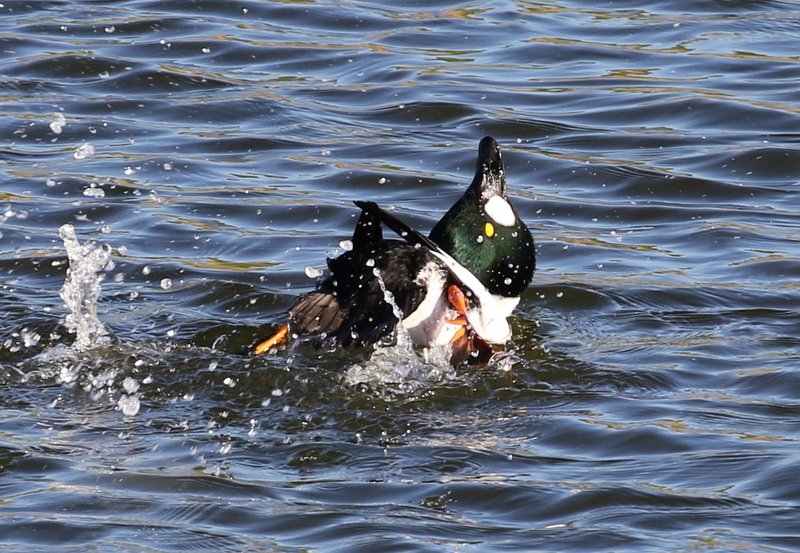 Goldeneye – a displaying drake on the pits today
Goldeneye – a displaying drake on the pits today
Leaving Snettisham, we made our way back along the coast road, stopping briefly at Holme to use the facilities, then on to Thornham Harbour. As soon as we got out of the car, we could see some waders in the harbour channel and the first bird we saw was a Greenshank, looking strikingly pale in the winter sunshine. It was with a Redshank,which looked much duller, darker grey by comparison, as well as being a little smaller.
Even more interesting, the Greenshank was carrying a set of colour rings. The arrangement of colours is used to identify the individual bird – only one should be fitted with this combination. Checking subsequently, it would appear that this bird was ringed in NE Scotland, and has also been seen at Titchwell this winter, although we are all still awaiting the details of its movements.
 Greenshank – this colour-ringed bird was ringed in NE Scotland
Greenshank – this colour-ringed bird was ringed in NE Scotland
There were some other waders here as well. A little further along, a second Greenshank was feeding in the shallow water with another Redshank. There were also a couple of Black-tailed Godwit and Curlew, and a single Little Egret too.
We made our way up onto the seawall, and walked along to the first corner. There was a nice selection of waders visible in the harbour from here, including a couple of Grey Plover. We looked up to see a small falcon flying towards us. It was a Merlin, flapping hard to gain height before it flew overhead and disappeared off west towards Holme.
It was time for lunch, so we headed round to Titchwell. As we ate in the car park, a flock of Long-tailed Tits worked its way through the trees nearby. After lunch, we walked over to the visitor centre. The feeders there were very busy – as well as a selection of tits, there were lots of finches. We watched several Chaffinch, Goldfinch and Greenfinch feeding before we picked up a Brambling in the bushes behind. It dropped down to the ground below the feeders.
Walking out along the main path, the grazing marsh ‘pool’ looked rather devoid of life at first. A closer look revealed a Jack Snipe in the ditch along one side, bobbing up and down constantly as it fed. We could see its golden straw mantle stripes and shorter bill than a Common Snipe. Then we picked out a Water Pipit at the back, in the far corner. Again, in the bright morning light its white underparts really stood out.
The freshmarsh is completely flooded at the moment. The water levels have been raised to kill off the vegetation on the islands, most of which are now underwater. Consequently, there are fewer birds here now. The ducks still seem to like it, with plenty of Teal, Wigeon and Shoveler out there today. Flocks of Brent Geese kept flying in from the saltmarsh to bathe and preen.
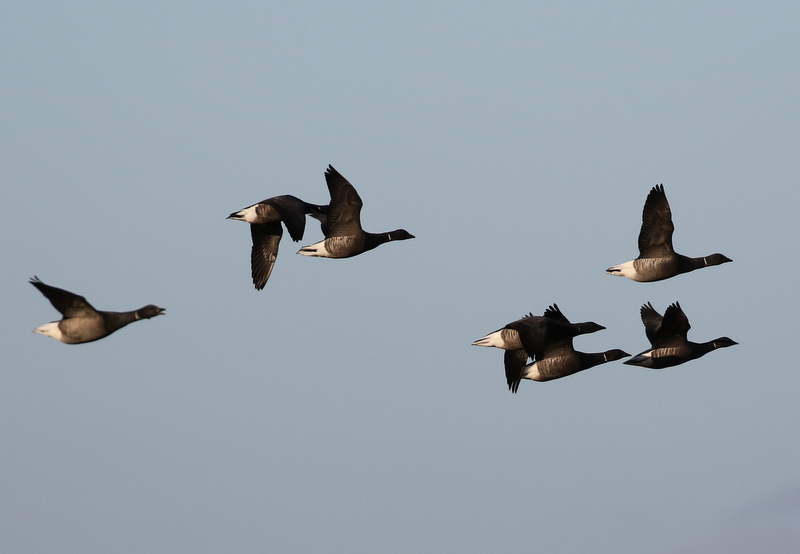 Brent Geese – flying in to bathe and preen on the freshmarsh
Brent Geese – flying in to bathe and preen on the freshmarsh
With the water levels high on the freshmarsh, many of the waders are now on the other pools. There were plenty of Curlew, Redshank and Grey Plover as well as several Black-tailed Godwit on the Volunteer Marsh. One Black-tailed Godwit was feeding in the channel right below the path, giving us great views.
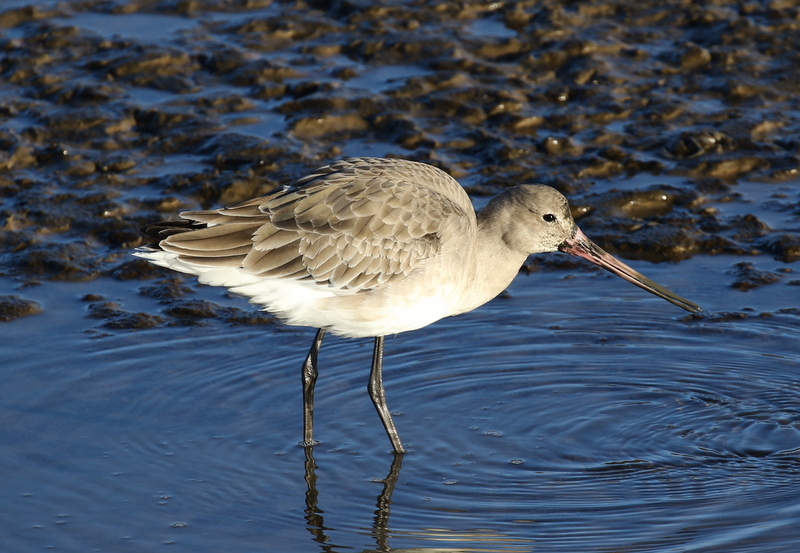 Black-tailed Godwit – feeding on the Volunteer Marsh
Black-tailed Godwit – feeding on the Volunteer Marsh
There were a couple of female Teal feeding on the mud, skimming their bills back and forth over the surface, feeding on the algae there. A stunning drake Teal was standing on the mud the other side of the channel, calling. It looked absolutely stunning in the sunshine – they really are very pretty ducks.
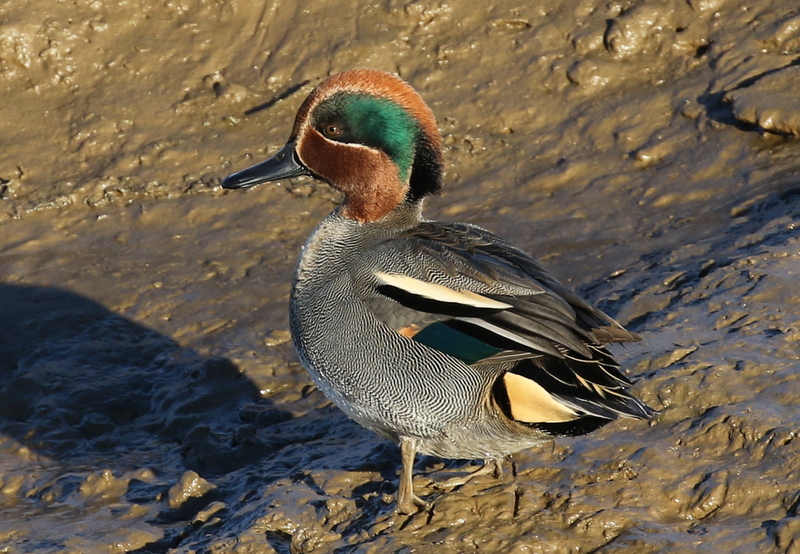 Teal – looking stunning in the sunshine
Teal – looking stunning in the sunshine
However, it was the Tidal Pools where most of the action was at today. As soon as we came over the bank from the Volunteer Marsh, we could see several Little Grebes out on the water. A couple of Little Grebes were diving just beside the path, giving us great views.
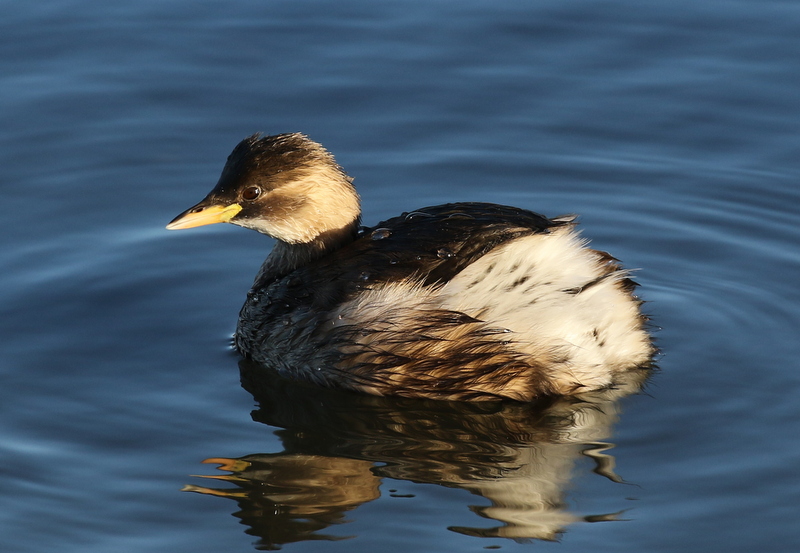 Little Grebe – diving just by the path on the tidal pools
Little Grebe – diving just by the path on the tidal pools
There were more ducks on here today, the usual Teal, Wigeon and Shoveler, together with several Pintail now. One was a smart drake, which we watched in the scope for a while. It was upending constantly, but eventually we got a good look at it. They have not yet quite grown their long pin-shaped central tail feathers, but still sport a rather pointed rear end.
On the muddy spit out in the middle, we could see several waders asleep. Most of the Avocets which spent the summer here have long since departed, but a few hardy individuals try to stay over the winter. There were still ten today, although they were all asleep with their bills tucked in. One of the two Spotted Redshanks was awake and we got a good look at it through the scope, noting its silvery grey upperparts, paler than a Common Redshank, and its long, fine, needle-tipped bill.
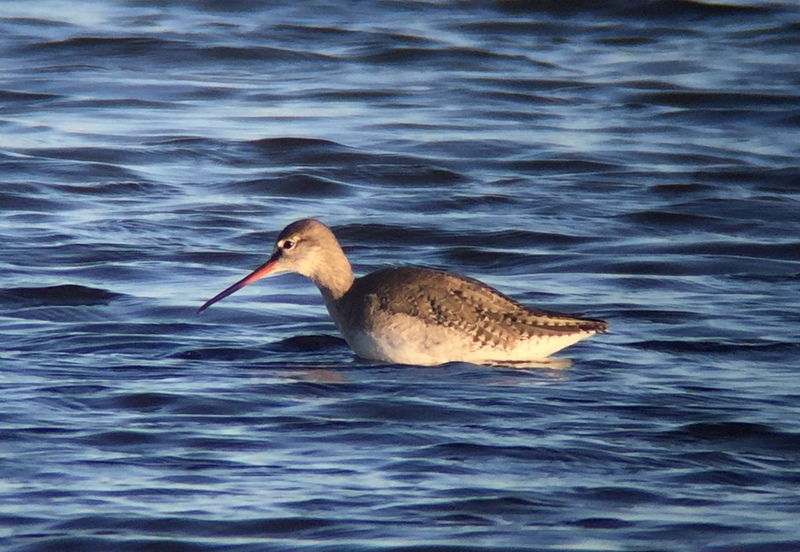
A single Ringed Plover was roosting with a couple of Dunlin at first, but when they all flew round it disappeared. Right at the far end of the tidal pools, we found it again, this time accompanied by a second Ringed Plover. A third tried to join them but one of the others tired to see it off. It appeared to be displaying – flying round with exaggerated wingbeats, then landing on a small island and bowing deeply at the interloper.
 Ringed Plover – displaying on the tidal pools
Ringed Plover – displaying on the tidal pools
A Kingfisher appeared, on the concrete bunker behind the beach, and it had a fish in its bill. It proceeded to beat it on the bunker’s edge repeatedly, presumably to kill or stun it, before eating it. It then flew round to the bushes on the edge of the water to look for more. We could hear a Water Rail squealing and looked over to see it working its way along the edge of one of the islands, probing in the vegetation.
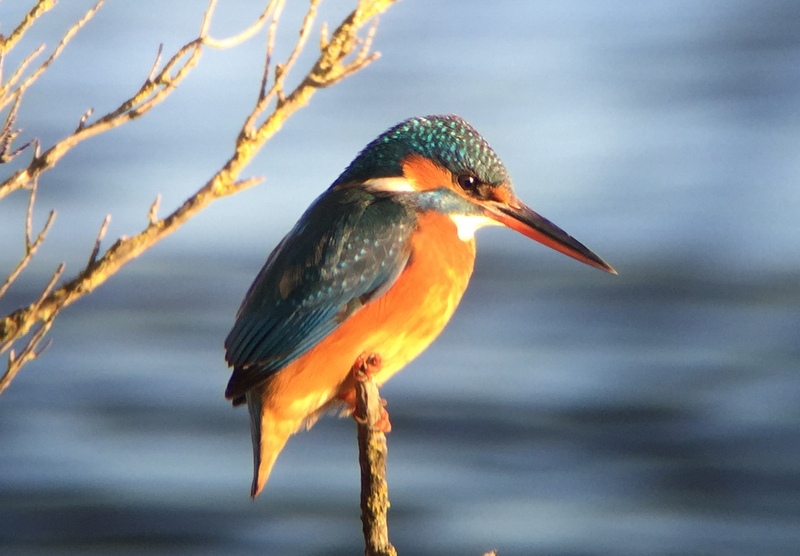 Kingfisher – catching fish on the tidal pools
Kingfisher – catching fish on the tidal pools
Then we made our way out onto the beach. One glance at the sea and we could see lots of sea ducks flying round. In amongst the dark-winged Common Scoter, we could see several Velvet Scoter with their obvious white wing patch. There were loads of Long-tailed Ducks too. They have been rather scarce in recent years, so it is great to see so many of them here at the moment. There were at least twenty this afternoon, and probably a lot more – they are hard to count in the swell, even though it is not that big!
One of the locals kindly came over to point out that there was a Great Northern Diver close inshore, so we walked down to the water for a closer look. It was diving constantly, but we managed to get a good view of it between dives. The ducks had now settled back onto the sea again, so we managed to get both Velvet Scoter and Long-tailed Duck in the scope. There were waders to look at on the beach too – Bar-tailed Godwits, Knot, Sanderling and lots of noisy Oystercatchers.
The sun was starting to go down and it was cold on the beach, so we started to walk back. We paid a brief visit to Parrinder Hide. There were lots of Wigeon feeding on the bank right outside the windows of the hide – amazingly close! A few more Wigeon were on the water in front, along with a single drake Pintail, again looking very smart but lacking his full length of tail.
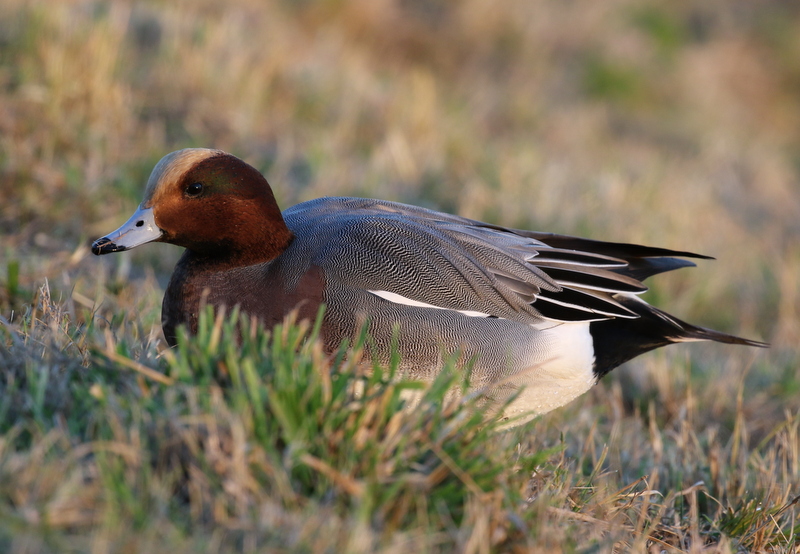 Wigeon – a smart drake, feeding on the bank right outside Parrinder Hide
Wigeon – a smart drake, feeding on the bank right outside Parrinder Hide
There was a single Common Snipe from the hide too, feeding along the water’s edge at the bottom of the bank. We got it in the scope and had a good look at it, probing its long bill into the soft ground.
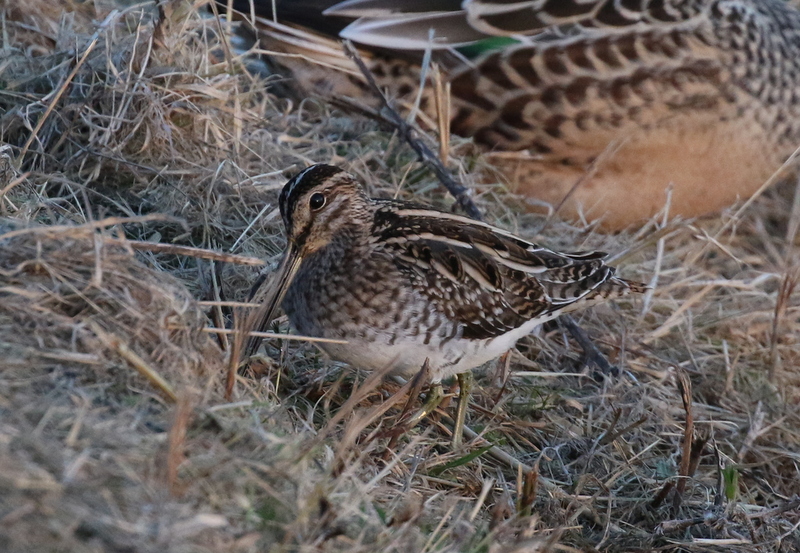 Common Snipe – also feeding on the bank outside Parrinder Hide
Common Snipe – also feeding on the bank outside Parrinder Hide
Making our way back towards the visitor centre, we could see several Marsh Harriers circling over the back of the reedbed. There were at least six, or at least that was the number we had in the air together. Another couple flew in over the saltmarsh from the Thornham direction.
 Marsh Harrier – flying in to roost at dusk
Marsh Harrier – flying in to roost at dusk
There was a glorious sunset away to the west this evening, a beautiful orange sky against which to watch the Marsh Harriers flying in. It was also a lovely way to draw an end to a great weekend.
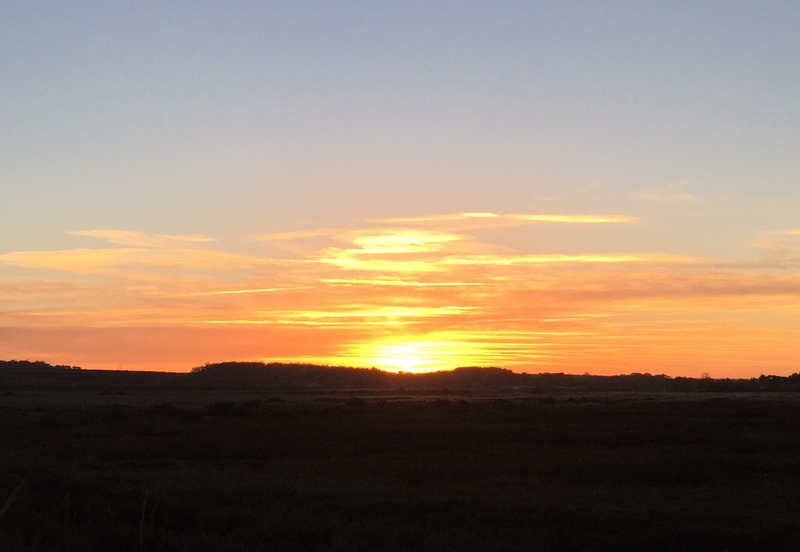 Sunset – looking towards Thornham from Titchwell
Sunset – looking towards Thornham from Titchwell
















